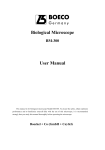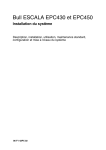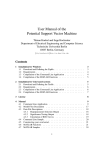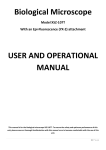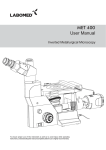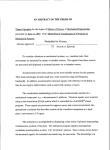Download Kwality Micro Scientific India User Manual
Transcript
Kwality Micro Scientific India User Manual This manual is for biological microscope Model KXL-4000, KXL-2001, KXB-1001,KXB-1005. To ensure the safety, obtain optimum performance and to familiarize yourself fully with the use of this microscope, it is recommendedstrongly that you study this manual thoroughly before operating the microscope All Right Reserve KWALITYMICRO SCIENTIFIC (India) USER NOTICE KWALITY Microscope 1. Safety Note 1. Open the box carefully to avoid the accessories, like lens, dropping to ground or being damaged. 2. Do keep the instrument out of direct sunlight, high temperature or humidity, dusty and easy shaking environment. Make sure the stage is flat, horizontal and firm enough. 3. When moving the microscope, carefully carry it with the handle and the base. 4. When running, the lamp house and nearby parts will be very hot. Please ensure there is enough cooling room for them. 5. Make sure the instrument is earthed, to avoid lighting strike. 6. For safety, be sure the main switch is in (off) state and cut off the power supply before replacing the bulb or the fuse. If you replace the bulb during use or right after use, allow the lamp bulb and the lamp house to cool completely before touching. 7. Check the input voltage: be sure the input voltage that is signed in the back of the microscope is consistent with the power supply voltage, or it will bring a serious damage to the instrument. (If they are different with each other, you can change the input voltage by switching the voltage changeover switch.) 8. Always use the power cord provided by Novel. II Maintenance and Care 1. All the lenses have been adjusted properly; do not dismount them by yourself please. 2. The nosepiece and coarse and fine focusing parts are so delicate that it is forbidden to disassemble them carelessly by yourself. 3. Keep the instrument clean, and do not pollute the optical element when wiping away the dust on the instrument. 4. The contaminations on the prism, like fingerprints and oil smudges, could be gently wiped with a piece of soft cloth or tissue paper, gauze which has been immersed in pure alcohol or ether. Note that the alcohol and ether are highly flammable, do keep them away from the fire or potential sources of electrical sparks, and use them in a drafty room as possible as you can.) 5. Do not attempt to use organic solvents to clean the microscope components other than the glass components. To clean them, use a lint-free, soft cloth slightly moistened with a diluted neutral detergent. 6. When using, if the microscope is splashed by liquid, cut off the power at once, and wipe away the splash. 7. Do not disassemble any parts of the microscope, as this will affect the function or reduce the performance of the microscope. 8. Place the instrument in a cool, dry position. When not using the microscope, keep it covered with a dust cover. Make sure the lamp socket is cool before covering the microscope. 2 Assembly 2-1 Assembly Diagram The following figure shows the installation sequence of the components. Before installing, be sure every components is clean, do not score any parts or glass surface. Keep well with hexagon wrench provided. When changing the components, you will need it again. Main body Objective Binocular viewing head 10X Eyepiece 2.2 Assembly Procedure 2.2.1 Installing binocular viewing head Insert the binocular viewing head into the microscope head and turn it to a proper position, then screw down the bolt to fix it. 2.2.2 Installing the eyepiece Insert the eyepiece into the eyepiece tube until they are against each other 2.2.3 Installing the objective 1. Adjusting the coarse focus knob until the support device of the mechanical stage reaches its low limit position. 2. Screw the lowest magnification objective into the nosepiece from the left or the right side, then revolve the nosepiece clockwise and mount other objectives by the sequence of low to high magnification Installing objective this way will make the change of magnification to be easier during using. Clean the objective regularly, for lens is susceptible to dust. When operating, use 10×magnification objective to search and focus specimen firstly, then replace with higher magnification objective if necessary. When replacing the objective, slowly turn the nosepiece until you hear “clicked”, that means the objective is in place. .2.4 Mounting the filters 1. Place the required filter in front of the condenser.. the filter of the standard outfit is baby blue. 2.2.5 Connecting the Power The cable and cords are vulnerable when bent or twisted, never subject the power cord to excessive force. 1. Set the main switch to (off) state before connecting the power cord. 2. Insert the plugs into the power jack of the microscope safely. 3. Plug the power cord receptacle into the power supply . Make sure the connection is well. Do use the supplied power cord all the time. If lost or damaged, select the same standard cord, please. A wide range of voltage ,like 100V 240V, is acceptable for this microscope. 2.2.6 Replacing the fuse Do remember to set the main switch to the state (OFF) and unplug the power cord before replacing the fuse. Rotate the fuse holder out of the with the “--”type screwdriver, replace with a new fuse, then rotate it back to the holder again. 3.2.1 Brightness Adjustment 1. Connect the power cord and set the main switch to “ ”state (ON). 2. Turning the brightness adjustment knob clockwise, the voltage raise, and the brightness strengthen; whereas turning at the contra direction, the voltage decline, and the brightness weaken. 2.T Using the microscope with low voltage in the voltage range can prolong the service life of the bulb. 3.3.2 Placing the Specimen 1. Place the specimen in the center of the mechanical stage and use the stage clips to clamp it. 2. Turn the portrait and lateral adjustment knob of the mechanical ruler, move the specimen to the required position. Be careful when changing the objective. If you finish the observation with the short working distance objective, and want to change another one, be careful of not letting the objective touch the specimen. 3.3.3 Focusing the Specimen 1. Focus the specimen with 10X objective. To avoid the objective touching the specimen during focusing, you should raise the mechanical stage to let the specimen close to the objective at first, then slowly separate them to bring the specimen to focus. Turn the coarse focus knob conversely to lower the specimen and search images in the 10×ocular simultaneously, and then use the fine knob to focus. After that, you can replace with other magnification objectives safely, and focus without the risk of damaging the specimen. To make the observation more convenient, you can use the locking set to fix the stage in a vertical direction. 3.3.4 Condenser Adjustment Turn the condenser focus knob to move the condenser up and down. Raise the condenser when using the high magnification objective, and descend it when using the low magnification one. The condenser and the objective are coaxial. It has been adjusted before leaving factory, so the user needn’t to adjust them by self The highest position of the condenser has been adjusted too. It also needn’t any user’s operation. 3.3.5 Aperture Iris Diaphragm Adjustment Turn the aperture iris diaphragm collar to adjust the aperture iris diaphragm. The aperture iris diaphragm is designed for the adjustment of the numerical aperture, not for the brightness. Generally, setting the aperture iris diaphragm to 70- 80% of the N.A. of the objective in use will provide an image with good contrast. If you want to observe the image of the aperture iris diaphragm, remove one eyepiece and look through the tube. You will see a dark circle encroaching on the bottom of the tube. 3.3.6 Adjusting the Interpupillary Distance The interpupillary distance range: 55mm 75mm While looking through the eyepieces, move both eyepieces until the left and right fields of view coincide completely. 3.3.7 Adjusting the Diopter 1. Turn the eyepiece to adjust the diopter while looking through it. The diopter range of the eyepiece is ±5 diopter. The number aligned to the line on the viewing head is the diopter in use. 3.3.8 Adjusting the tension adjustment collar Turn the tension adjustment collar with your fingers .When the collar is turned in the direction of the arrow, tension of the coarse adjustment knob increases. Turning the collar in the opposite direction decreases the tension. If the nosepiece descends on its own or if the specimen gets out of focus quickly even when it is brought into focus using the fine adjustment knob , it means the tension of the coarse adjustment knob is too low. Turn the collar in the direction of the arrow to increase the tension 4 Technical Specifications 1) Main Specifications KWALITY Microscope Optical System Achromatic optical system Viewing Head Compensation Free Binocular or Trinocular Head, 30°Inclined, Interpupillary Distance: 48-75 mm Eyepiece Wide Field Eyepiece with field of view φ20 (mm) Nosepiece Quadruple Nosepiece Objective Plan Achromatic Objectives 4× 10× Focusing Coaxial Coarse and Fine Adjustment, Moving Range20mm, Fine 40× 100× Division 0.002mm Condenser Abbe Condenser NA=1.25 Stage Double Layers Mechanical Stage 160mm×140mm Moving Range 76×50mm Illumination 2) Halogen Lamp 6v-20w, / 12v-20/30W Eyepiece and objectives Magnification Numerical Aperture Focal Length mm Working Length Objective mm 4× 0.10 45.3 17 dry 10× 0.25 17.96 6 dry 40× 0.65 4.5 0.37 dry 100× 1.25 1.81 0.13 oil KWALITY Microscope Mfd- Kwality Micro Scientific (An ISO 9001 co) 5337,Punjabi Mohalla Nr-B.D.High school AMBALA CANTT-133001 (INDIA) TEL- +91-171-4006034 E- [email protected]










